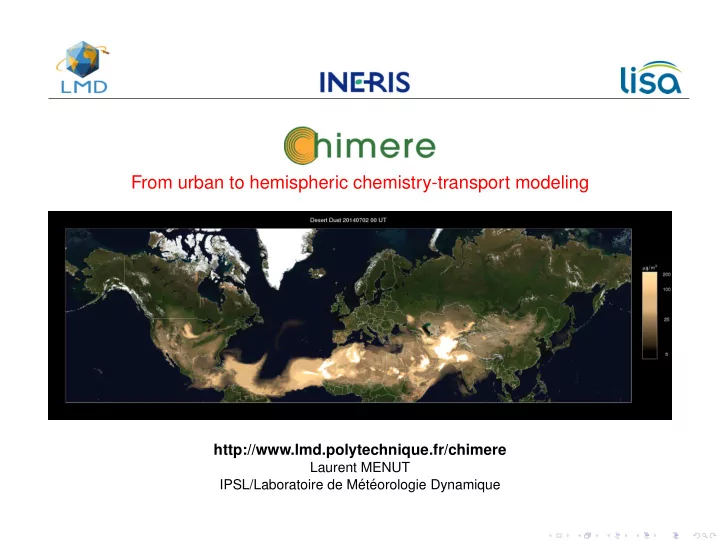

From urban to hemispheric chemistry-transport modeling http://www.lmd.polytechnique.fr/chimere Laurent MENUT IPSL/Laboratoire de M´ et´ eorologie Dynamique
A chemistry-transport model for research on processes, scenarios and forecast PREVAIR forecast: www.prevair.org Used for: Physical and chemical processes research Transport and mixing, turbulence Gas and aerosols chemistry Anthropogenic, biogenic, dust and fire emissions Dry and wet deposition Scenarios and climatologies Past and future emissions impacts Ensemble analysis ECMWF-MACC ensemble forecast Forecast Experimental forecast at LMD during specific field experiments Operational forecasts: In Europe: COPERNICUS MACC In France: PREVAIR Over many regions: Regional air quality networks Status: Freely distributed under GPL licence French INSU national tool (since 2007) Open-source langages and databases
Current model version: 2017 In free access on the model web site: http://www.lmd.polytechnique.fr/chimere The CHIMERE users More than 300 users (registered on the e-mail list), In more than 120 research institutes (universities, air quality networks, private companies, etc.)
Current model version and developers Model developments: 3 institutes (LMD, INERIS, LISA) 9 developers At LMD: 2 permanent people for the development: Observatory Physician: Myrto Valari (2011) CNRS researcher: Laurent Menut (1998), coordination (since 2006) No CNRS Research Engineer : Dmitry Khvorostyanov in now working in another lab For questions about: Total: The model use: Researchers: 2.7 persons.year chimere-users@lmd.polytechnique.fr Engineers: 0 persons.year The model schemes: chimere@lmd.polytechnique.fr
How to use the model? For academic research use: 1 Register on the CHIMERE web site 2 Download the code, the documentation and all databases 3 Try the studied case already prepared For private or industrial use, or operational forecast: 1 Contact the INERIS developers Developments 1 The developments priorities are managed by the developers group 2 The users may propose new developments for integration in the distributed version 3 The development team proposed the code but is not designed to run simulations for users
Model developments Not only a chemistry-transport model Many programs and tools are provided for: Build adaptated landuse and soil properties Build initial and boundary conditions Build meteorological fields on the CHIMERE grid with an hourly time-step Build emissions: anthropogenic, biogenic, dust, fires Compare model outputs to observations (surface, lidars, satellites data etc.) Plot results as maps, time series, vertical cross-sections etc. Other distribution Some ”parts” of CHIMERE are also directly distributed to colleagues: The mineral dust databases and programns for emissions: LMDz, POLYPHEMUS, AROME The biomass burning databases and programs for emissions: POLYPHEMUS The aerosol scheme: co-development between CHIMERE and POLYPHEMUS
Model developments: Example with the anthropogenic emissions Methodology of anthropogenic sources regridding Need to have anthropogenic emissions on the (mass conservation) specific model grid and with the correct model Example with the EMEP grid in Europe: species Development of the open-source emisurf program Read regional or global databases New in the last version: 1 Use proxies to project the raw data on fine grids European Pollutant Release and Transfer Register (EPRTR) for industrial sources CORINE land cover + roads from ETISplus + population 2 Code parallelized The traffic proxy:
Model developments: The hemispheric version → in 2017 model release Why an hemispheric version? To have new boundary conditions estimated with the same model, same chemical mechanism, at an hourly time-step and for the same studied event. In order to allow simulations of long-range transport for fires, mineral dust, volcano plumes This development induced: To update the EMISURF code To rewrite the horizontal transport scheme in CHIMERE
Model developments: The on-line version Add interactions between meteorology (radiation) and aerosols concentrations The direct effect: aerosols and radiative fluxes The indirect effect: cloud formation Methodology: Use of an external coupler OASIS (developed at CERFACS) Currently, development with WRF only Direct effect: impact on 2m temperature But flexible and open to other models Constraints: developed and optimized for fast runs Perspectives: Add vegetation in the coupling (ORCHIDEE) Status: direct effects OK, indirect effects under development (Briant et al., 2017)
Recommend
More recommend